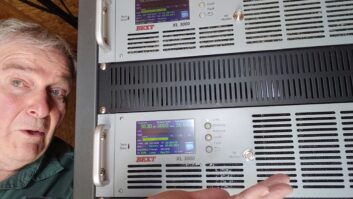Photos
(click thumbnail)Fig. 1: Harry Bingaman used parts from his junk box to make this protective switch cover.
(click thumbnail)Fig. 2: The cover in place.
(click thumbnail)Fig. 3: Road Ready Cases offers cooling fans and transport rollers in its line of cases.
Solving a problem gives any engineer a boost. But if we solve it using items from the junk box, well, that really makes our day.
Consider the phasor or pattern controller. It’s not an issue when located at an out-of-the-way transmitter site; but collocate these pushbuttons with a studio and at some point someone’s going to want to experiment.
For sure, mode change may be tied to the remote control. But having selection access for maintenance is helpful. The issue is how to keep curious fingers at bay.
Harry Bingaman, engineering manager for Sunbury Broadcasting, fashioned a removable switch cover, seen in Figs. 1 and 2, using spare parts. The panel can be removed easily for maintenance access, and the cover keeps the switches “out of sight and out of mind.”
* * *
Here’s a neat idea: Combine a heavy-duty road case with built-in electric cooling fans!
California-based Road Ready Cases is where you find “Cool Cases” that bring much-needed relief for remote broadcasters as well as production companies.
The Cool Cases line will cool live gear by an average of 12 degrees F. The company looks for new ways to further the life of customers’ gear; this built-in safeguard, seen in Fig. 3, will guard against overheating. Note the built-in transport rollers. No more hand truck!
The company’s motto is, “Built for the Rigors of the Road.” Give ’em a look if you need a heavy-duty case for your remote or PA equipment.
For information on Road Ready Cases and the company’s product catalog, go to www.roadreadycases.com.
* * *
Ron Schacht works for Three Eagles Communications out of Lincoln, Neb., handling stations in Iowa and Eastern Minnesota. He has suggestions for those who have problems running their UPS from a generator. Ron has encountered this situation several times and so far has found it to be caused by three issues.
First, and most common, is the generator output frequency. Since just about all UPS systems use ferroresonant transformers, they won’t accept 57 or 63 Hz. They need exactly 60 Hz to tell the rest of the UPS that the world is fine.
So how do you tell what your generator is generating? You can use a small filament transformer on the generator to drive a frequency counter or oscilloscope to get the generator governor to run at whatever speed is necessary to produce 60 Hz. The governor should hold the frequency to 60 Hz, regardless of the load.
You can usually locate the governor easily; it is linked to the carburetor throttle plate and has a big spring on it with an adjusting screw. Too many times people adjust these for voltage and not frequency.
The second issue is generator voltage. It should be within the tolerance of the UPS, say 110 to 130 volts. This is adjusted in the newer generators by a pot in the electronic field regulator circuit. Older generators have what looks like a multi-pole relay with a large coil. Each contact has a slightly different spring tension; as contacts pull in and drop out depending on voltage, different resistances are inserted in the field winding to adjust output voltage. Although these are trickier to adjust, you can set them, with patience. Just make sure you are operating with normal load when you do the tinkering.
The third situation Ron has encountered is with cheaper generator sets. On these temporary contractor-type generators, you may find spikes on the output waveform, caused by the output voltage regulators using SCRs.
Look at the output of the gen set. You may see big spikes on the sine wave. Ron has had luck sticking a couple of MFDs (microFarads) of AC motor starting capacitors across the output. Although it upsets the power factor in a positive way, and reduces the output capacity of the generator somewhat, it will smooth out the waveform enough to let the UPS run fine. Just make sure that the capacitors you use are the AC motor type; generally about 10 uF is enough. Ron has used motor caps for split phase motors rated at 330vac too.
These are not the only reasons a UPS won’t run on a generator, but they’re the ones Ron has encountered in the prairies of the upper Midwest.















